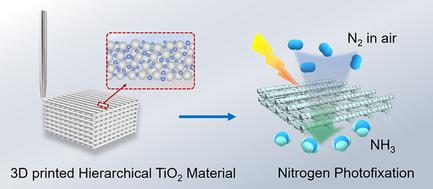当前位置:
X-MOL 学术
›
Adv. Eng. Mater.
›
论文详情
Our official English website, www.x-mol.net, welcomes your
feedback! (Note: you will need to create a separate account there.)
3D Printing of Powder‐Based Inks into Functional Hierarchical Porous TiO2 Materials
Advanced Engineering Materials ( IF 3.4 ) Pub Date : 2019-11-11 , DOI: 10.1002/adem.201901088 Chenyang Xu 1 , Ting Liu 1 , Wei Guo 1 , Yinghui Sun 2 , Chu Liang 3 , Kunli Cao 1 , Tianfu Guan 1 , Zhiqiang Liang 1 , Lin Jiang 1
Advanced Engineering Materials ( IF 3.4 ) Pub Date : 2019-11-11 , DOI: 10.1002/adem.201901088 Chenyang Xu 1 , Ting Liu 1 , Wei Guo 1 , Yinghui Sun 2 , Chu Liang 3 , Kunli Cao 1 , Tianfu Guan 1 , Zhiqiang Liang 1 , Lin Jiang 1
Affiliation

|
Integrating multifunctional semiconducting metal oxide powders into a 3D printing technique to construct hierarchical porous structures is highly desirable and remains a significant challenge. Herein, an extrusion‐based 3D printing strategy is developed that can assemble TiO2 powders into hierarchical porous structures with multiscale pores at both the macro‐ and microscale. Powder‐based TiO2 inks with a significant shear‐thinning behavior and adequate storage modulus and yield stress are developed to meet the requirements of 3D printing of TiO2 in an air environment without the need for an additional solidification treatment, which provides good printing flexibility. The hierarchical porous structures with a relatively high compressive strength provide the 3D‐printed TiO2 structures with great potential for use in many applications, including filtration, thermal insulation, biomedical scaffolds, catalyst supports, and energy conversion. Compared with scaffolds with a compact morphology, the hierarchical porous TiO2 scaffold as a photoelectrode achieves a higher nitrogen photofixation yield due to its high surface adsorption and activation capacity caused by its porous morphology. Importantly, the powder‐based ink design and extrusion‐based 3D printing approach are readily extended to other semiconducting metal oxides such as ZnO and their composites.
中文翻译:

粉末基油墨在功能性多层多孔TiO2材料中的3D打印
将多功能半导体金属氧化物粉末整合到3D打印技术中以构建分层的多孔结构是非常需要的,并且仍然是一个重大挑战。在此,开发了一种基于挤压的3D打印策略,该策略可以将TiO 2粉末组装成在宏观和微观尺度上均具有多尺度孔的分层多孔结构。开发了具有显着的剪切稀化行为,足够的储能模量和屈服应力的粉末基TiO 2油墨,以满足TiO 2的3D打印要求无需额外的固化处理即可在空气环境中使用,从而提供良好的印刷灵活性。具有较高抗压强度的分层多孔结构为3D打印的TiO 2结构提供了巨大的潜力,可用于许多应用,包括过滤,隔热,生物医学支架,催化剂载体和能量转换。与形态紧凑的脚手架相比,分层多孔TiO 2由于其多孔形态引起的高表面吸附和活化能力,作为光电极的支架可实现更高的氮光固定率。重要的是,基于粉末的墨水设计和基于挤出的3D打印方法很容易扩展到其他半导体金属氧化物,例如ZnO及其复合材料。
更新日期:2019-11-11
中文翻译:

粉末基油墨在功能性多层多孔TiO2材料中的3D打印
将多功能半导体金属氧化物粉末整合到3D打印技术中以构建分层的多孔结构是非常需要的,并且仍然是一个重大挑战。在此,开发了一种基于挤压的3D打印策略,该策略可以将TiO 2粉末组装成在宏观和微观尺度上均具有多尺度孔的分层多孔结构。开发了具有显着的剪切稀化行为,足够的储能模量和屈服应力的粉末基TiO 2油墨,以满足TiO 2的3D打印要求无需额外的固化处理即可在空气环境中使用,从而提供良好的印刷灵活性。具有较高抗压强度的分层多孔结构为3D打印的TiO 2结构提供了巨大的潜力,可用于许多应用,包括过滤,隔热,生物医学支架,催化剂载体和能量转换。与形态紧凑的脚手架相比,分层多孔TiO 2由于其多孔形态引起的高表面吸附和活化能力,作为光电极的支架可实现更高的氮光固定率。重要的是,基于粉末的墨水设计和基于挤出的3D打印方法很容易扩展到其他半导体金属氧化物,例如ZnO及其复合材料。











































 京公网安备 11010802027423号
京公网安备 11010802027423号